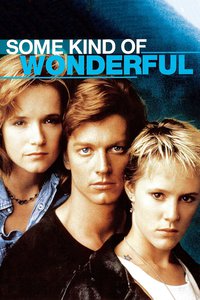Some Kind of Wonderful (1987)

Pretty in Pink, released two years earlier, was such a success that eighties teen movie king John Hughes decided to give the love triangle in that film a bit of a gender flip. This time, we get arty outsider Keith (Stoltz) in love with the school’s most popular girl, Amanda Jones (Thompson), not realising that his best friend and fellow outsider, Watts (Masterson), is in love with him.
Keith has decided that he can be accepted within the confines of the modern American high school if only he can engineer a date with Amanda Jones (her character is always referred to by both names, so that when they play a remake of the Rollling Stones hit Miss Amanda Jones later on, we’re all quite clear who’s being referenced). To this end, he enrols the unwilling help of his tomboy best friend, Watts, who is so overtly in love with him, you wonder how sensitive Keith can be as an artist if he’s missed something this obvious right in front of his face:
Keith: You can’t judge a book by its cover.
Watts: Yeah, but you can sure tell how much it’s gonna cost.
Also helping out is school bully, Duncan (Koteas), who Keith meets in detention and whose sole purpose appears to be to provide the comic relief in the film. Of course, Amanda already has a boyfriend—nasty, sneering rich kid, Hardy Jenns (Sheffer), whose life revolves around looking good, cheating on Amanda and keeping the school social class system in order.
To say it’s formulaic would be an understatement, but the script is slightly better and more sardonic than other Hughes efforts . Okay, so it requires a major suspension of disbelief, mainly because everyone looks way too old to be in high school, but there’s a couple of decent performances lurking beneath the formula. The cynical tone of Keith’s little sister (Maddie Corman) is a welcome relief from Keith’s earnest demeanour. And Masterson is much spikier than other eighties teen leads, bringing a touch of dysfunctional believability to a world that otherwise doesn’t exist outside of John Hughes’ mind.
Interestingly, like Duckie from Pretty in Pink, the Watts character is coded gay throughout. Maybe both films would have been better if these two characters had been allowed to be the gay best friend, but that wasn’t happening in mainstream movies in the 80s. Also, Masterson is the best thing on offer throughout, and Watts is a clearly damaged but resilient individual who always has the strength of her convictions.
Although it was one of the last and one of the less profitable eighties teen comedies, it’s the perfect example of that bubblegum genre. And, on its own very undemanding terms, it succeeds better than many others starring bigger Brat Pack names.